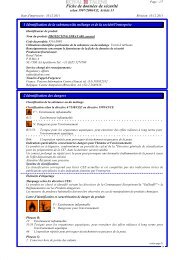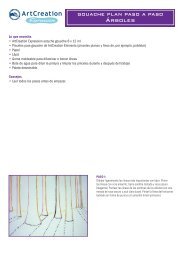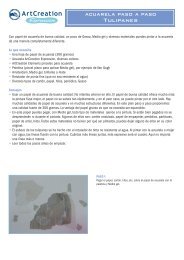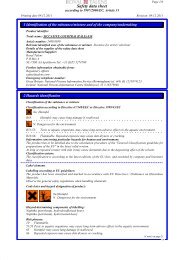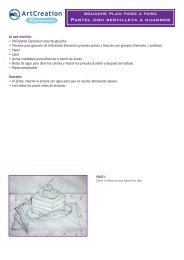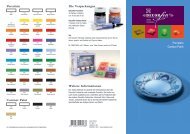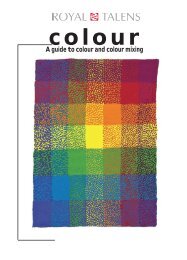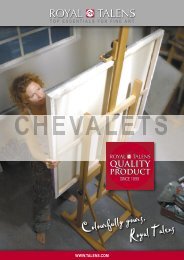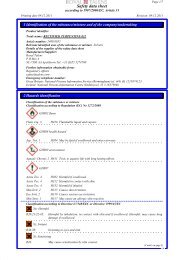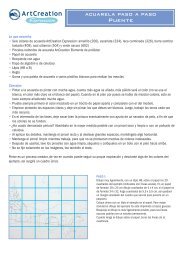AUXILIARIE - Royal Talens
AUXILIARIE - Royal Talens
AUXILIARIE - Royal Talens
Create successful ePaper yourself
Turn your PDF publications into a flip-book with our unique Google optimized e-Paper software.
Introduction<strong>Royal</strong> <strong>Talens</strong> maintains close contact with the users of its products.We increasingly come across questions regarding the application ofauxiliaries for the various types of paint. When do you use what productand at what stage of the painting process? How can you bestprotect your work? For oil paint in particular the range of auxiliaries isextensive, making it difficult to choose.Many of the questions concern the desired visual result and the durabilityof the work. Starting painters often want to know what and howmuch needs to be purchased to be able to paint.In our search for answers we found there to be extensive knowledgeavailable. Various publications and books offer a wealth of information;however, upon closer inspection they are often not always unequivocaland sometimes even inconsistent or too technical.This booklet gives answers to many questions in a concise and clearmanner; the text is clarified using clear illustrations. The type of auxiliaryto use will not be the same for everyone; every artist has hisown way of working. A large section of this booklet therefore focuseson explaining paint properties and painting techniques. On the basisof this it will be possible to make a sound and well-informed choiceregarding auxiliaries.44The <strong>Talens</strong> auxiliaries for oil colours, water colours,gouache, soft pastels and oil pastels are described onthe following pages.Auxiliaries for acrylic colours are highlighted in the brochure‘Acrylic auxiliaries’, article number 88150064.Auxiliaries for Cobra water mixable oil colour are mentionedin the Cobra brochure, article number 88390014.In addition to its range of auxiliaries, <strong>Royal</strong> <strong>Talens</strong> offersvarious types of paint under the brands Rembrandt,Cobra, Van Gogh, Amsterdam, <strong>Talens</strong> and ArtCreation.
CONTENT5Introduction 41. OIL COLOUR 71.1 Composition of oil colour 81.2 Drying of oil colour 81.3 Adhesion of oil colour 81.4 Oil painting techniques 9Alla prima 9Layered painting 9Fat over lean 9Glazing 111.5 Auxiliaries for oil colour 12Primer for oil colour 13• <strong>Talens</strong> Gesso Primer 1001 13Solvents for oil colour 14turpentine 14• <strong>Talens</strong> Rectified turpentine 032 14White spirit 15• <strong>Talens</strong> White spirit 090 15• <strong>Talens</strong> Odourless white spirit 089 15Cleaning paint brushes and varnish brushes 16Mediums for oil colour 17Painting medium 17• <strong>Talens</strong> Painting medium 083 17• <strong>Talens</strong> Painting medium quick-drying 084 18Glazing medium 18• <strong>Talens</strong> Glazing medium 086 18Venetian Turpentine 19• <strong>Talens</strong> Venetian Turpentine 019 19Alkyd medium 20• <strong>Talens</strong> Alkyd medium 007 20Painting paste 21• <strong>Talens</strong> Painting paste 096 22Oils for oil colour 23Purified linseed oil and bleached linseed oil 24• <strong>Talens</strong> Purified linseed oil 027 24• <strong>Talens</strong> Bleached linseed oil 025 24Boiled linseed oil 25• <strong>Talens</strong> Boiled linseed oil 026 25Stand oil 26• <strong>Talens</strong> Stand oil 031 26• <strong>Talens</strong> Poppy oil 028 26Varnishes for oil colour 27retouching varnish 27• <strong>Talens</strong> Retouching varnish 004 28Final varnish 28
1.1 Composition ofoil colourOil colours are made of a drying oil and pigment.The most frequently used oils are linseed oil andsafflower oil. The finer the pigment is dispersed inthe oil, the greater the tinting strength. Dependingon the pigment used, the drying time may vary percolour. In order to avoid big differences in dryingtimes, siccatives can be added to the paint. Theyspeed up the drying process.Linseed oil, which is obtained from the seedsof the flax plant, has for more than five hundredyears been the most important binder of oil paints.Other drying oils result in a less durable film layer,can greatly darken or have a drying time that isfar too long. There is, unfortunately, no oil that isoptimal for every desired property. Throughoutthe ages linseed oil has proven to incorporatethe best combination of properties. As linseed oilin time does show a certain degree of yellowing,it is often replaced by poppy oil or safflower oil,particularly for white paint. Poppy oil and saffloweroil are chemically virtually identical and, therefore,similar in their applications by artists.Safflower oil is extracted from the seeds of thesafflower. This oil yellows less than linseed oil.The drying time, however, is longer and the oilforms a paint film with different properties thanthat of linseed oil. When white based on saffloweroil is used in layered painting, whereby it forms anunder layer for colours based on linseed oil, it cancause crackling or even the detachment of the toplayers of paint. It is advisable to restrict the useof white paint based on safflower oil to the finalphase of the painting.Under the brand names Rembrandt, Van Goghand Amsterdam, <strong>Royal</strong> <strong>Talens</strong> provides whitesbased on both linseed oil and safflower oil.1.2 Drying of oil colourThe drying of the oil is a chemical process thatoccurs under the influence of air and light. Oxygenis absorbed by the oil and binds the moleculesto one another to form a firm network. Energyis necessary for this oxidation process, whichis primarily supplied through the ultraviolet partof light. This entire process, which can take upa considerable length of time, is the reason whyit takes so long for oil paints to dry. The greaterthe ventilation, the more light and the higher thetemperature, the quicker the paint dries.A low environmental temperature and a high airhumidity have an adverse effect on the drying.1.3 Adhesion of oil colourFor a good adhesion of the oil paint the groundmust be prepared well and have a certain degreeof porosity. The oil from the paint penetrates thepores and during drying the paint film adheresto the preparation layer through numerous little‘anchors’.88GENERAL
1.4 Oil painting techniquesThere are in theory two oil painting techniques:‘alla prima’ and ‘layered painting’.Alla primaAlla prima refers to the painting being painted‘wet-into-wet’. With this technique the coloursare not only mixed on the palette, but also in thepainting itself and the colours are applied wetalongside and over one another. The painting,which is ultimately built up from a single layer,must be completed while the paint is still wet.The paint can be applied pure or combined withalways the same medium or solvent.9Layered paintingWith layered painting the painting is built from various layers. A next layer can only be applied once theprevious layer is dry enough to ensure that it will definitely not dissolve. With layered painting a techniquehas to be followed that is known as ‘fat over lean’; every subsequent layer has to contain more oil.Step 1 Step 2 Step 3Fat over leanEnsure the first layer is applied lean. To achievethis, the paint has to be thinned with white spiritor turpentine. While this layer dries it will notproduce a sealed paint film, but a porous one.Oil from a subsequent layer will be absorbed bythe underlying lean layer and secure itself in thenumerous pores while drying. This will producegood adhesion between the two layers. As anunderlying (lean) layer draws oil from the layerabove, you have to ensure during painting thatthe layer above contains relatively more oil. If thisis not the case, all sorts of quality problems canarise.OIL COLOUR
111GlazingWhether you paint using the wet-into-wettechnique or paint in layers, a glazing can beapplied as a final layer. This is a transparentpaint layer which has roughly the same effect asplacing a coloured sheet of glass over a picture.The picture doesn’t change, but the colours do. Aglazing can be applied, for example, if the artistis not quite happy about the colours and wantsto change them somewhat without having topaint over entire areas. Also, the artist may wishto achieve the visual effect of glazing layers:an enamel-like top layer and deep colours. Anunderpainting would then be used as a startingpoint to modify the colour of the entire paintingwith one or several layers of glazing. Brushstrokes must not be visible in a glazing as youwill continue to see the brush stroke of theunderlying layers through the transparent paint;a glazing medium therefore has to flow. Thanksto this property you can also make flowing colourtransitions in a glazing. Take care: a layer ofglazing has to be more elastic than the underlyingpaint film as here, too, the ‘fat over lean’ rule hasto be followed. Various mediums are suitable forthis purpose.Step 1Step 2Step 3You cannot always foresee exactly how manylayers are needed to come to a satisfactory result.Ensure, therefore, that the paint is never too fatso that any subsequent paint layer is still ableto bond. Pure oil as a medium is certainly notadvisable; the paint can then become too sealedresulting in a subsequent layer not being able tobond well. What’s more, with too muchoil there is a greater risk of the paint filmwrinkling during the drying process.tIPStep 4It is recommended that flat soft-haired brushes beused, of for example red sable or ox hair, in order toget an attractive, even glazing layer.oil colour
12121.5 Auxiliaries foroil colourFor a good technical structure of an oil paintingone or more auxiliaries are often essential. Auxiliariesfor oil colours can be divided into six sorts.• Primer• Solvents• Mediums• Oils• Varnishes• Miscellaneous auxiliaries<strong>AUXILIARIE</strong>S
White spiritWhite spirit is a mineral oil distillate that consistsof a mixture of all sorts of hydrocarbons. Variousmixtures are possible, resulting in a diverse rangeof qualities of white spirit. The composition of themixture is responsible for, for example, the odourand its dissolving capacity. Hydrocarbons with thebest dissolving capacity generally have a strongodour. Odourless or virtually odourless white spiritvarieties have a lower dissolving capacity.<strong>Talens</strong> White spirit 090Purpose: Thinning oil colour and cleaning brushes and other artists’ materialsComposition: Mineral oil distillate515• Very pure, 100% evaporation; disappears completely from the paint film• Makes oil paint leaner (use in lower layers)• Suitable for removing (dry) varnish coats• Suitable for dissolving synthetic resins• Also for thinning mediums and varnishes for oil colour• Flammable• Available in: 75 ml and 250 ml<strong>Talens</strong> Odourless white spirit 089Purpose: Thinning oil colour and cleaning brushes and other artists’ materialsComposition: Mineral oil distillate with the minimum possible contentof harmful constituents• Odourless• Drying time somewhat longer than <strong>Talens</strong> white spirit (090)• Very pure, 100% evaporation; disappears completely fromthe paint film• Makes oil paint leaner (use in lower coats)• Not suitable for removing dry varnish coats• Available in: 75 ml and 250 mlOil colour
Mediums for oil colourThe purpose of a medium is to influence oneor more properties of the paint and to make thepaint suitable for a certain application. Examplesinclude consistency, gloss, flow, drying time,transparency and durability of a paint film.As a lower (lean) layer absorbs oil from an upperlayer, the upper layer must contain relatively moreoil. Apply here the fat over lean rule.Painting mediumThe addition of <strong>Talens</strong> Painting medium addsextra oil to the paint. This helps to prevent theupper layer eventually containing too little oil.What’s more, the resins make the paint filmmore durable. In addition, <strong>Talens</strong> Paintingmedium quick-drying has siccatives added to it.Siccatives increase the rate of oxygen absorptionand consequently the drying of the paint. Thesemediums are the modern replacements forthe traditional ‘mediums’ linseed oil and boiledlinseed oil.717Mixingpaintingmedium andpaint<strong>Talens</strong> Painting medium 083Purpose: Increasing the flow and/or transparency of oil colour, and makingthe paint fatterComposition: Vegetable oils, synthetic resins, white spirit• No influence on the drying time of the paint• Increases the durability and elasticity of the paint film• Makes the brush stroke run slightly, depending on the amount added• Increases gloss• Does not yellow• Can be thinned with white spirit or turpentine• Flammable• Available in: 75 ml, 250 ml and 1000 mlOil colour
919Venetian TurpentineThe name Venetian Turpentine has a historicalbackground. This turpentine balsam extractedfrom an Austrian larch used to be traded viaVenice. This traditional glazing medium is valuedfor its handling properties. It has a positive effecton gradual colour transitions and the elasticity ofthe paint film.<strong>Talens</strong> Venetian Turpentine 019Purpose: Increasing the flow and transparency of glazing layers in oil colourComposition: Natural balsam, turpentine oil• Traditional glazing medium• Increases the drying time of the paint film• Increases the durability of the paint film• Makes the brush stroke run, depending on the amount added• Increases the gloss• Slightly yellowing• Can be thinned with white spirit or turpentine• Flammable• Available in: 75 ml and 250 mlOil colour
Alkyd medium<strong>Talens</strong> Alkyd medium can be used as a paintingmedium and glazing medium. When used as apainting medium the fat over lean rule must befollowed. The medium is fairly fat and can bemade leaner with white spirit or turpentine. Inthe final layer and for glazing techniques Alkydmedium can be used pure.2020<strong>Talens</strong> Alkyd medium 007Purpose: Increasing the flow and/or transparency of oil colour, making the paintfatter, decreasing the drying timeComposition: Alkyd resin, white spirit• Increases the durability and elasticity of the paint film• Makes the brush stroke run, depending on the amount added• Hardly influences the degree of gloss• Slightly yellowing• Can be thinned with white spirit or turpentine• Suitable as glazing medium• Flammable• Available in: 75 mlmediums
Painting paste<strong>Talens</strong> Painting paste is a colourless medium thatcan be mixed with oil paint in any proportion. Thethickness is the same as that of the paint, and sothe paste can be described as an oil paint withoutpigment. Painting paste has various applications:Preventing wrinkling in thick paint layersWrinkling may occur during drying if paint isapplied in a heavy layer. Whether or not a paintlayer will wrinkle depends in part on the pigment.Cobalt blue, burnt umber, madder and metallicand pearlescent colours are all examples ofwrinkling colours. Adding painting paste to thepaint helps to prevent this wrinkling. The amountto be added depends on the extent to which thecolour concerned wrinkles. Between 20 and 40%is usually enough.121Pure paintwrinkles in athick layerIncreasing the amount of paintPainting paste can be mixed with oil paints in anyproportion. In this way more paint can be made ofexpensive colours without any resulting differencein colour. This is done particularly when applyingthick layers of paint, the impasto technique. Themore paste is added, the more transparent thepaint becomes; depending on the type of pigmentthis will not or hardly be visible in thicker layers.Decreasing the tinting strengthThe tinting strength of the paint will decrease inproportion to the amount of Painting paste that isadded. This can be particularly important when,using the alla prima (wet-into-wet) technique,colours with widely ranging tinting strengths aremixed with one another on the painting. By addingmore Painting paste to a strong colour, this colourwill become less dominant.Addingpainting pastepreventswrinklingOil colour
Mixingpaintingpaste andpaintStep 1Step 22222Step 3<strong>Talens</strong> Painting paste 096Purpose: Preventing the wrinkling of thick paint layers, increasing theamount of paint, decreasing the tinting strength and increasing thetransparency of oil colour while retaining the viscosityComposition: Vegetable oils, synthetic resins, thickening mediums,white spirit• Increases the durability of the paint film• Slightly reduces the gloss of oil colour• Reduces the drying time of the paint film• Does not yellow• Can be thinned with white spirit or turpentine• Flammable• Available in: 60 mlmediums
Oils for oil colourThe various <strong>Talens</strong> oils serve primarily asingredients for the artist to prepare his ownmediums and paint. It is not recommended touse pure oil as a medium. A medium must neverconsist of more than 40% oil. This would make thepaint film too fat and too sealed making it difficultfor a next layer to adhere onto it. What’s more, themore oil is added, the greater the risk of wrinkling.Makingyour ownpaint:Step 1:Dosedadding of oil323Step 2:Mixing withpainting knifeStep 3:Grindingpigment with amullerStep 4:The resultOil colour
Purified linseed oil and bleachedlinseed oilThe designations ‘purified’ and ‘bleached’ arisefrom the time when the seed shells and mucilagepresent were removed from the oil after havingbeen pressed from the linseed. These days thelinseed oil is purified and bleached in a similarmanner, although the method is now much moresophisticated. The result is a very pure and isas colourless as possible an end product withlittle difference between purified and bleachedlinseed oil.<strong>Talens</strong> Purified linseed oil 027Purpose: For the artist to make his own paint and painting mediumComposition: Linseed oil• Increases the gloss and the drying time of the paint film• Increases the risk of the paint film wrinkling• Shows strong yellowing in dark conditions, which largelydisappears in daylight• Can be thinned with white spirit or turpentine• Available in: 75 ml and 250 ml2424<strong>Talens</strong> Bleached linseed oil 025Purpose: For the artist to make his own paint and painting mediumComposition: Linseed oil• Increases the gloss and the drying time of the paint film• Increases the risk of the paint film wrinkling• Shows less yellowing in dark conditions than Purified linseed oil;the yellowing largely disappears in daylight• Can be thinned with white spirit or turpentine• Available in: 75 ml and 250 mloils
525Boiled linseed oilThe heating of linseed oil while oxygen andsiccatives are being added causes partialoxidation. The result is a quicker drying oil. Whenusing boiled linseed oil extra siccatives mustnever be added; this is in connection with thedurability of the paint film. Too much siccativespeeds up not only the drying but also the ageingprocess, consequently also resulting in possibleearly crack formation.<strong>Talens</strong> Boiled linseed oil 026Purpose: For the artist to make his own medium and as an ingredient for apaint formulaComposition: Linseed oil, siccatives• Increases the gloss and reduces the drying time of the paint film• Increases the risk of the paint film wrinkling• Shows strong yellowing in dark conditions, which largelydisappears in daylight• Not to be used as medium in lower layers• Can be thinned with white spirit or turpentine• Is darker in colour than the other linseed oils• Available in: 75 ml and 250 mlOil colour
Varnishes for oil colour727Retouching varnishSunken-in areas can arise during painting. Thiscan occur if in a particular area too much oilis absorbed by an underlying layer; the paintbecomes matt and the colour loses intensity.Once the sunken-in areas are hand-dry, applya thin layer of retouching varnish in order toreturn gloss and colour to the area. After dryingthe varnish leaves a porous film onto which asubsequent paint film can adhere. When used forthis application retouching varnish can sometimesalso be referred to as ‘intermediate varnish’.In addition, retouching varnish can be used as atemporary protective varnish on paintings that arenot yet completely dry (wait at least 2 to 3 monthsbefore applying it). This gives the painting an evengloss and protects it against dirt. Since the varnishis porous (in a thin layer), oxygen absorption anddrying process of the paint can continue. Oncethe paint is completely dry, a final varnish can beapplied over the retouching varnish.Take care: It is very important that the retouchingvarnish is always applied in very thin layers. Withexcessive use, the solvent of the varnish candissolve the oil from the lower paint layers thatare not yet dry and bring it to the surface. If thishappens the painting may remain sticky for manymonths or even years, and will make it difficult tostop dust from adhering to it.Applyingvarnish layerwith a varnishbrushOil colour
<strong>Talens</strong> Retouching varnish 004Purpose: Reviving sunken-in (matt) areas and providing temporary protection(temporary final varnish) of oil paintings not entirely dryComposition: Synthetic resin, white spirit• Apply sparingly• Does not affect the further drying time of the paint film• As temporary protective varnish do not apply until after 2-3 months• Dries in a few hours• Does not yellow• Can be thinned with white spirit• Clean brushes with white spirit• Highly flammable (in spray can: extremely flammable)• Available in: 75 ml, 250 ml, 400 ml (spray can) and 1000 ml2828Final varnishOil paint dries through the absorption of oxygen.This is a chemical process. Once the paint isentirely dry this oxidation process does not stopbut continues in an ageing process. Eventuallythis can be visible as crackling. Once the paintis entirely dry (with layers of normal thicknessthis takes approximately one year, with verythin layers several months less, and with thickerlayers several years) it is advisable to apply a finalvarnish. This final varnish slows down the oxygenabsorption and the ageing process. The varnishalso determines the degree of gloss and protectsagainst atmospheric contaminationWhen varnishing, ensure that everything(painting, varnish, brush and trays) are at roomtemperature. If the painting is taken out of a coldroom into a warm room in order to be varnishedcondensation can form on the cold painting.Moisture would therefore be sealed within thevarnish resulting in a white film. What’s more, themoisture on the painting can cause the varnish tobead and result in poor adhesion.Beading can also occur if the paint layer is verysealed, for example when this contains a greatdeal of binder (medium, oil). In order to preventthis it is advisable to first wipe the painting with acloth with some white spirit. Once the white spirithas evaporated the varnish can be applied.VARNISHES
Glossy picture varnishes consist mainly of aresin in a solvent. In the case of matt varnishesa matting agent has been added. When usinga brush to apply a varnish with a matting agent(therefore also with mixtures of glossy and mattvarnish), it is important that the varnish is appliedat the end in brush strokes in one direction. Thishelps to ensure a uniform degree of gloss.What’s more, it is important that a varnish with amatting agent is applied in one layer. This helps toprevent differences in gloss and stripe formation.If, however, matt varnish is applied with a spraycan, this can be done in several layers.929tIPWhen using a spray can it is possible without any problems toapply a matt varnish over a glossy varnish. This is useful if adifferent degree of gloss is decided upon later.<strong>Talens</strong> Picture varnish glossy 002Purpose: Durable protection of an oil painting (final varnish)Composition bottle: Synthetic resin, turpentine oil, white spiritComposition spray can: Synthetic resin, white spirit• Apply when paint film has completely dried(approx. 1 year with normal layer thickness)• Dries in a few hours• Does not yellow• Gives a high gloss• The gloss can be decreased by mixing with Picture varnish Matt 003• Can be thinned with white spirit or turpentine• Clean brushes with white spirit or turpentine• Dry varnish coats can be removed with white spirit or turpentine• Flammable (in spray can: extremely flammable)• Available in: 75 ml, 250 ml, 400 ml (spray can) and 1000 mlOil colour
<strong>Talens</strong> Picture varnish matt 003Purpose: Durable protection of an oil painting(final varnish)Composition bottle: Synthetic resin, turpentine oil, waxesComposition spray can: Synthetic resin, white spirit, silica• Apply when paint film has completely dried(approx. 1 year with normal layer thickness)• When applying with a brush do so in one layerand in one direction• The degree of gloss is increased when mixed with Picture varnish Gloss 002• Dries in a few hours• Does not yellow• Varnish in bottle gives a satin gloss, varnish in spray can is matter.• Can be thinned with turpentine• Clean brushes with white spirit or turpentine• Dry varnish coats can be removed with white spirit or turpentine• If the contents become cloudy place bottle in warm water• Flammable (in spray can: extremely flammable)• Available in: 75 ml, 250 ml, 400 ml (spray can) and 1000 mltIPThe matting agent in<strong>Talens</strong> Picture varnish mattis a combination of waxesthat flocculates under lowtemperatures. By heatingup the varnish (‘au bainmarie’ or under tricklinghot water) the waxes aredissolved and the varnishcan be used again.3030<strong>Talens</strong> Acrylic varnish gloss 114Purpose: Durable protection of an oil painting or acrylic painting (final varnish)Composition: Acrylic resin, white spirit, turpentine oil• Apply when paint film has completely dried (with normal layer thickness for oilcolour after approx. 1 year, for acrylic paint after 4 to 5 days)• Dries in a few hours• Does not yellow• More flexible than Picture varnish gloss 002• Gives less gloss than Picture varnish gloss 002• Mixing with Acrylic varnish matt 115 reduces the degree of gloss• Dry varnish coats can be removed with white spirit or turpentine• Can be thinned with white spirit or turpentine, clean brusheswith white spirit or turpentine• Flammable (in spray can: extremely flammable)• Available in: 75 ml and 400 ml (spray can)VARNISHES
tIPUse <strong>Talens</strong> Acrylic varnish gloss if you wish toachieve a degree of gloss that is slightly less thana high gloss. If, however, a high gloss is desiredthen use <strong>Talens</strong> Picture varnish glossy or <strong>Talens</strong>Dammar varnish glossy.131<strong>Talens</strong> Acrylic varnish matt 115Purpose: Durable protection of an oil painting or acrylic painting (final varnish)Composition: Acrylic resin, white spirit, turpentine oil, matting agents (silicas)• Apply when paint film has completely dried (with normal layer thickness for oilcolour after approx. 1 year, for acrylic paint after 4 to 5 days)• When applying with a brush do so in one layer and in one direction• Do not use on strongly absorbent grounds• Does not yellow• More flexible than Picture varnish matt 003• Produces a matter look than Picture varnish matt 003• Mixing with Acrylic varnish glossy 114 increases the degree of gloss• Can be thinned with white spirit or turpentine, clean brushes withwhite spirit or turpentine• Dry varnish coats can be removed with white spirit or turpentine• Shake well before use• Flammable (in spray can: extremely flammable)• Available in: 75 ml and 400 ml (spray can)NB Acrylic varnish owes its name to the composition of the varnish:a solution of acrylic resin in mild solvents. The varnish is suitable forworks in both oil and acrylic paint.Oil colour
<strong>Talens</strong> Dammar varnish glossy 081Purpose: Protecting an oil paintingComposition: Dammar resin, turpentine oil• Traditional final varnish• Apply when paint film has completely dried (approx. 1 year with normallayer thickness)• Dries in a few hours• May show signs of ageing after some time such as yellowingand crackling• Gives a high gloss• Mixing with Dammar varnish matt 082 reduces the degree of gloss• Can be thinned with turpentine, clean brushes with whitespirit or turpentine• Dry varnish coats can be removed with turpentine• Highly flammable• Available in: 75 ml and 250 ml3232<strong>Talens</strong> Dammar varnish matt 082Purpose: Protecting an oil paintingComposition: Dammar resin, turpentine oil, matting agents (wax and silica)• Traditional final varnish• Apply when paint film has completely dried(approx. 1 year with normal layer thickness)• Dries in a few hours• May show signs of ageing after some time such as yellowing and crackling• Gives a satin gloss• Apply in one layer and in one direction• Mixing with Dammar varnish glossy 081 increasesthe degree of gloss• Can be thinned with turpentine, clean brushes withturpentine or white spirit• Dry varnish coats can be removed with turpentine• Shake well before use• Highly flammable• Available in: 75 ml and 250 mlVARNISHES
Miscellaneous auxiliaries foroil colourSiccativesSiccatives speed up the rate of oxygen absorptionand consequently the drying time of the paint. Thedrying of oil paints can occur on the surface anddeep in the paint itself. The light <strong>Talens</strong> SiccativeCourtrai mainly increases the drying in depth. Thedarker <strong>Talens</strong> Siccative Harlem increases boththe surface drying and the drying in depth. AsSiccative Harlem contains both oil and resins, itcan be referred to as a very quick-drying medium.As layered painting always requires the “fat-overlean”technique to be followed in connection witha good adhesion between the paint layers, it is notadvisable to use the fatter Siccative Harlem in thelower layers. The use of siccatives must be keptto a minimum, as not only the drying process isaccelerated but also the ageing process.333<strong>Talens</strong> Siccative Courtrai (pale) 030Purpose: Reduces the drying time of oil coloursComposition: Metal compounds, white spirit• Reduces the elasticity and durability of the paint film;use very sparingly (add maximum 2%)• Can be thinned with white spirit• Flammable• Available in: 75 ml<strong>Talens</strong> Siccative Harlem (dark) 085Purpose: Reducing the drying time of oil coloursComposition: Metal compounds, resins, oil, white spirit• Reduces the elasticity and durability of the paint film;use very sparingly (add maximum 10%)• Can be thinned with white spirit• Flammable• Available in: 75 mlOil colour
535Casein Tempera binderBefore the development of oil paints in the 15thcentury the so-called ‘tempera’ paints were usedin particular. The name comes from the Latinword ‘temperare’, which means to mix. The mostimportant tempera paints are ‘egg tempera’ and‘casein tempera’. A characteristic of these types ofpaint is that they can be mixed with both water andoil. Just as certain components of an egg, casein(a component of milk) also makes it possible toMixing proportionsCaseinTempera binderand oil colourdisperse oil droplets homogenously throughoutwater. Such a dispersion is called an emulsion.By mixing equal parts of casein tempera binderand oil paint (never more oil paint than Caseintempera binder) a water mixable paint is createdthat once dry, produces a matt and lean paint film.This technique is often used for an underpaintingthat is completed with oil paint, particularly inglazing techniques.<strong>Talens</strong> Casein tempera binder 103Purpose: Making a water mixable casein tempera paint in combinationwith oil coloursComposition: Casein solution, thickening and matting agents, emulsifier• Mix 1 part of binder to a maximum of 1 part of oil colour• Gives a satin gloss when dry• Dries quickly to a virtually waterproof finish• Highly suitable for making underpaintings with oil painting techniques• Available in: 60 mlOil colour
water colour3636A water colour is made from Gum arabic dissolved in water in which the pigments havebeen very finely ground. The finer the pigment, the more transparent the colour. In theorywater colour can be used to paint on any type of paper, although the best results areachieved by using water colour paper. Water colour paper has a special surface sizing,usually of gelatine. This sizing ensures that the pigment is not absorbed by the paperso that the colours remain pure. What’s more, the sizing helps to prevent the paper fromcockling too much when a lot of water is used. When painting the colours are thinned withwater on a mixing tray and if desired mixed with one another.water colour
2.2 Auxiliaries forwater colourFor working with water colours a number ofauxiliaries are available to use during painting orto protect a work.Liquid masking filmWhite paint is usually not used in the water colourtechnique. The places on the painting that haveto be white are simply not painted upon. Butsometimes, during the course of painting, paintmay accidentally get onto these areas, and theunwanted paint may not be completely washableusing water. It is advisable to first treat the areato be kept white with <strong>Talens</strong> Liquid masking filmbefore painting. This is a product based on latex(natural rubber).Once dry it can be simply painted over. Oncethe painting is ready and the paint dry, theLiquid masking film can then simply be rubbedoff from the paper using a (clean) finger or aneraser. This reveals the white of the paper again.The longer the Liquid masking film remains onthe paper the stronger it will adhere to it. It istherefore best to remove the Liquid masking filmwithin a few days.3838Step 1:Applyingliquidmasking filmStep 2:Applying anew paintlayerStep 3:Removingliquidmasking filmStep 4:The resultwith blankareasAuxiliaries
<strong>Talens</strong> Liquid masking film 052Purpose: Temporary masking of sections in a water colour paintingComposition: Dispersion of natural rubber in water• Prevents adhesion of water colour to areas of the painting that are treatedwith Liquid masking film• Dries in 10 minutes• Once dry remove with the fingertips or an eraser within a few days• Becomes more difficult to remove after some time• Can cause discolouration on cellulosic paper• Can also be used for water-based inks• Available in: 75 ml939tIPBrushes used to apply Liquidmasking film are difficult toclean. It is best to use olderbrushes or other ‘implements’,such as a match, cotton budsor the other end of a brush.water colour
Ox gall<strong>Talens</strong> Ox gall is used to enable the adhesionof water-based paint on a greasy ground.Sometimes water colour or gouache producesbeading on the paper because that area of thepaper is too greasy. This can be caused by thegrease from skin getting onto the paper whenholding it. The beading can easily be remedied byadding a small amount of Ox gall to the paint. Thisreduces the surface tension of the paint making iteasier for the paint to run. Only add as much as isnecessary; too much Ox gall can cause the paintand the colour to penetrate the ground too deeply.Beadingpaint ongreasyfingerprintUsing oxgall preventsbeading4040<strong>Talens</strong> Ox gall 051Purpose: Prevents beading and improves the adhesion of water-basedpaints on somewhat hydrophobic groundsComposition: (Synthetic) surfactant, water• Can be added to the paint• Use sparingly to avoid strong absorption of the paint• Can also be used directly in order to degrease groundsother than paper with, for example, a cloth. Residues arethen removed with a clean damp cloth or sponge• Available in: 75 ml and 250 mlAuxiliaries
Varnishes for water colourIt is not usually necessary to varnish a watercolour. A water colour is normally framed behindglass or sealed in some other way. If there is,however, a particular reason to provide a watercolour with maximum protection against moisture,for example moist fingers, then a varnish iscertainly advised.<strong>Talens</strong> Water colour varnish matt 050Purpose: Making the painting less susceptible to moistureComposition: Colourless, non-yellowing acrylic resin, white spirit,matting agents (silica)141• Dries in a few hours• Little influence on the degree of gloss• Does not yellow• Water resistant when dry, making the painting less susceptible to moisture• Ready for use, do not thin• Apply in one layer and in one direction• Not suitable for extremely absorbent grounds• Shake before use• Clean brushes with white spirit• Highly flammable• Available in: 75 ml and 250 ml<strong>Talens</strong> Protecting spray 680Purpose: Protecting works carried out in, for example, gouache, water colour and inksComposition: Colourless, non-yellowing acrylic resin, dissolved in,amongst others, white spirit• Short drying time• Layer thickness determines the degree of gloss (a thick layer givesa higher gloss)• Makes matt paint layers more transparent and colours deeper• Does not yellow• Water resistant when dry, making the painting less susceptible to moisture• Store in a cool and dry place• Extremely flammable• Available in: 150 ml and 400 ml (spray cans)water colour
GOUACHE4242Gouache is a highly pigmented opaque water colour. The binding agent used in gouache isusually dextrin, a processed (potato) starch with excellent water solubility. Due to its smallquantity of binding agent in combination with the high pigment levels, gouache has a mattappearance and very intense colours once dry. The dextrin makes the paint thixotropic;if the paint is left alone it remains thick. But if the paint is moved either through stirring,shaking or squeezed from the tube, it becomes thinner. Due to this property gouache flowswhen painting so that thin, even layers can be applied. Gouache dries quickly.gouache
Gouache can be applied on any grease-free andsomewhat absorbent ground, such as paper,cardboard and wood. Gouache is usually used onpaper. It is best to use water colour paper sincenormal drawing paper has a tendency to quicklycockle under the influence of water. Gouache isnot water-resistant when dry; the work thereforeremains sensitive to moisture.The <strong>Talens</strong> Gouache Extra Fine range has beenput together with the greatest of care and catersfor all possibilities for both professional use andeducational purposes.3.1 Auxiliaries for gouacheA number of auxiliaries are available for workingwith gouache. In addition to the productsdeveloped specially for gouache, such as <strong>Talens</strong>Goauche varnishes and Gum arabic, <strong>Talens</strong>Ox gall can also be useful. Ox gall can be usedto degrease the ground and so improve theadhesion of the paint and to prevent beading fromoccurring. Please also refer to page 40.Gum arabicFor a more vibrant and less even paint layer,<strong>Talens</strong> Gum arabic can be added to gouache. Thisreduces the thixotropic property and consequentlythe flow of the paint.343On the leftgouache withoutgum arabic, onthe right with gumarabic<strong>Talens</strong> Gum arabic 008Purpose: Changing the consistency of gouache, making the paint less thixotropicComposition: Gum arabic dissolved in water• Makes gouache more transparent• Increases the gloss• Increases the elasticity of gouache and thereby reducesthe risk of crackling in thicker paint layers• Available in: 75 mlgouache
Pastels545PASTELS
4.1 Soft pastelsThe composition of soft pastels allows colour onthe ground to approach that of pure pigment asmuch as possible. This is achieved through acombination of pigment, a minimum amount ofbinding agent and the purest and softest typesof kaolin, also sometimes referred to as pipeclay or china clay. The well-balanced proportionsof these ingredients result in a spontaneouscolour transfer and a velvety look. When usingpastels, the dry coloured powder of the pastel istransferred onto the ground. In theory, any groundcan be used, providing it has sufficient structure toits surface. It is advisable, however, to use specialpastel paper.In contrast to paint, pastels do not adhere tothe ground through a binding agent. The pastelpowder hangs, as it were, onto the fibres of thepaper. The particles can be fixed using fixativethat can be sprayed from a bottle with a fixativeatomiser or from a spray can.By fixing the work, the velvety look changesdepending on the amount of fixative used. If toomuch fixative is applied, the colours becomedarker and even then the work is not necessarilysmudge-proof. The best way to proceed is tolightly fix the pastel every time a new layer ismade. One can decide whether or not to lightly fixthe last layer depending on personal preferences.4646Applyingpastel fixativewith a fixativeatomiserApplyingpastel fixativewith a spraycanGENERAL
7474.2 Carré pastelsCarré pastels are square shaped and arecomposed of the same ingredients as softpastels, but with more kaolin. They are less softerand are ideal for sketching. Carré pastels have abetter adhesion than soft pastels but do not givea smudge-proof result. It is advisable to use afixative.4.3 Charcoal<strong>Talens</strong> Charcoal is made from carefully selectedwillow twigs. This traditional drawing material,charcoal, is soft and not smudge-proof. It is bestto fix the work. In contrast to coloured dry pastelsthe colour of a charcoal drawing does not changeif so much fixative is applied as to make thedrawing totally smudge-proof.4.4 Oil pastelsOil pastels are made of pigment, waxes and nondryingmineral oils. The material used for thepainting or drawing remains the same since noneof the ingredients undergoes any changes overtime. There is no drying process. An untreatedwork is not smudge-proof. This can be remediedby varnishing a work. This should not be donewith a varnish based on solvents since oil pastelsdissolve in white spirit and turpentine. For thisreason, a special water-based varnish has beendeveloped, which due to the specific compositionflows evenly on a greasy ground and does notbead. Oil pastels adhere to almost any ground,providing it is somewhat porous.Painting is notsmudge-proofunless treatedwith oil pastelvarnishPASTELS
4.5 Auxiliaries for pastelsand other drawingmaterialsA range of auxiliaries is available for a betteradhesion of the colour or to protect the work forworking with pastel, charcoal, chalk and graphitepencils. For dry types of pastel and drawingmaterials, these are fixatives. For oil pastels,there is a varnish.<strong>Talens</strong> Pastel fixative 061Purpose: Improving the adhesion of the particles of pastels to the surfaceComposition: Colourless resins, ethanol, acetone• Preferably apply in each pastel layer• Use sparingly• Apply using a fixative atomiser at approx. 40 cm distance• Quick-drying• Non-yellowing• Highly flammable• Available in: 75 ml and 1000 ml4848<strong>Talens</strong> Fixative for charcoal 063Purpose: Improving the adhesion of charcoal, chalk and graphite particlesto the surfaceComposition: Colourless resins, ethanol, acetone• Use sparingly• Apply using a fixative atomiser at approx. 40 cm distance• Makes colours darker and more transparent• Quick-drying• Non-yellowing• Highly flammable• Available in: 75 ml and 1000 mlAuxiliaries
<strong>Talens</strong> Concentrated fixative 064Purpose: Improving the adhesion of particles of pastels, charcoal, chalkand graphite to the surfaceComposition: Colourless resins, ethanol• In combination with pastel use preferably in every layer• Use sparingly• Quick-drying• Non-yellowing• More concentrated than Fixative for pastel 061• Retouches the so-called ‘blooming’ (white veil formation) incolour pencil drawings• Extremely flammable• Available in: 150 ml and 400 ml (spray cans)949<strong>Talens</strong> Varnish for oil pastels 060Purpose: Making work in oil pastel and wax crayon smudge-proofComposition: Synthetic dispersion in water with built-in surfactants• Dries within one hour to a colourless, transparent and waterproof finish• Gives a satin gloss• Has hardly any effect on the colours• Can be thinned with water• Shake before use• Available in: 75 mlPASTELS
5050Auxiliaries
Product range overview of<strong>Talens</strong> auxiliariesProduct number Content / article numberAuxiliaries for oil colourPrimers for oil colour 1000 ml 5000 ml 10000 ml<strong>Talens</strong> Gesso Primer 1001 24192001 24652001 24641001Solvents for oil colour 75 ml 250 ml 1000 ml<strong>Talens</strong> Rectified turpentine 032 24280032 24300032 24320032<strong>Talens</strong> White spirit 090 24280090 24300090<strong>Talens</strong> Odourless white spirit 089 24280089 24300089151Mediums for oil colour 60 ml 75 ml 250 ml 1000 ml<strong>Talens</strong> Painting medium 083 24280083 24300083 24320083<strong>Talens</strong> Painting medium quick-drying 084 24280084 24300084 24320084<strong>Talens</strong> Glazing medium 086 24280086 24300086<strong>Talens</strong> Venetian turpentine 019 24280019 24300019<strong>Talens</strong> Alkyd medium 007 24280007<strong>Talens</strong> Painting paste 096 24060096Oils for oil colour 75 ml 250 ml<strong>Talens</strong> Purified linseed oil 027 24280027 24300027<strong>Talens</strong> Bleached linseed oil 025 24280025 24300025<strong>Talens</strong> Boiled linseed oil 026 24280026 24300026<strong>Talens</strong> Stand oil 031 24280031<strong>Talens</strong> Poppy oil 028 24280028Varnishes for oil colour 75 ml 250 ml 1000 ml 400 ml<strong>Talens</strong> Retouching varnish 004 24280004 24300004 24320004 95160004<strong>Talens</strong> Picture varnish glossy 002 24280002 24300002 24320002 95160002<strong>Talens</strong> Picture varnish matt 003 24280003 24300003 24320003 95160003<strong>Talens</strong> Acrylic varnish glossy 114 24280114 95160013<strong>Talens</strong> Acrylic varnish matt 115 24280115 95160014<strong>Talens</strong> Dammar varnish glossy 081 24280081 24300081<strong>Talens</strong> Dammar varnish matt 082 24280082 24300082Miscellaneous auxiliaries for oil colour 60 ml 75 ml 150 ml<strong>Talens</strong> Siccative Courtrai (pale) 030 24280030<strong>Talens</strong> Siccative Harlem (dark) 085 24280085<strong>Talens</strong> Underpainting white 101 03071101<strong>Talens</strong> Casein Tempera binder 103 24060103product range overview
Product number Content / article numberAuxiliaries for water colour 75 ml 250 ml 150 ml 400 ml<strong>Talens</strong> Liquid masking film 052 24280052<strong>Talens</strong> Ox gall 051 24280051 24300051<strong>Talens</strong> Water colour varnish matt 050 24280050 24300050<strong>Talens</strong> Protecting spray 680 95160680 95161680Auxiliaries for gouache 75 ml 250 ml 1000 ml<strong>Talens</strong> Gum arabic 008 24280008<strong>Talens</strong> Gouache varnish glossy 074 24280074 24300074 24320074<strong>Talens</strong> Gouache varnish matt 107 24280107 24300107Auxiliaries for pastels 75 ml 1000 ml 150 ml 400 ml<strong>Talens</strong> Pastel fixative 061 24280061 24320061<strong>Talens</strong> Charcoal fixative 063 24280063 24320063<strong>Talens</strong> Concentrated fixative 064 95160006 95160016<strong>Talens</strong> Varnish for oil pastels 060 242800605252



